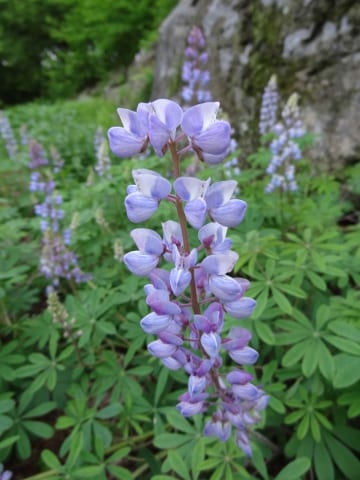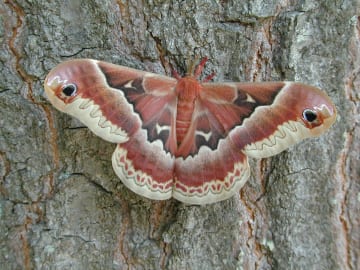by Cayte McDonough
Imagine you have been abducted by an alien spaceship, whisked away from your homeland, then deposited back on earth in a fast food restaurant. The place looks familiar, but you have no idea where you are. Thanks to the proliferation of fast-food chains and big-box stores, all Main Streets are starting to look alike, whether you are in Phoenix or on the Avenue des Champs-Élysées in Paris.
While it might be convenient to grab familiar food at a McDonald’s, nobody really wants to confuse Paris with Phoenix. We all yearn for the sense of place, whether visiting someplace new or just relaxing at home. In built environments, architecture helps define the character of each place; we expect gothic turrets along Parisian streets and pueblo style domiciles in southwestern deserts. In natural landscapes, the unique characteristics of the ecoregion and ecosystem define place. Maine is uniquely Maine because of its rocky coastline and spruce-fir forests.
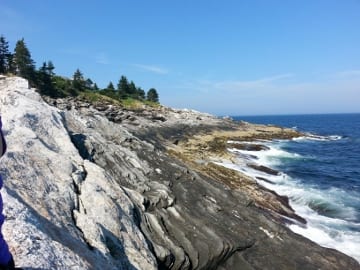
Native plant communities found on Maine’s rocky coast give a unique sense of place. Photo: Cayte McDonough
Whereas you could survive on fast food, in natural landscapes the diversity of native species that defines the character of a place is also essential to its survival. A diverse native plant community that supports, feeds, and shelters all other life is in fact key to a healthy ecosystem and ultimately a healthy planet, our home.
Why native plants?
As professionals in the landscaping industry, we make daily decisions about what plants to use whether in built landscapes or restored natural landscapes. By choosing to plant species native to our areas, we help preserve the regional character. Future generations deserve to experience our natural heritage and its inherent beauty. As a bonus, when it comes to long-term maintenance, native plants require very little attention. Having developed and co-evolved over centuries within an ecosystem, they are well adapted to the local climate and conditions.
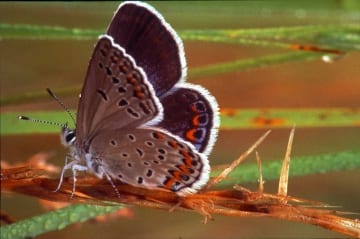
A specialist, the rare Karner Blue feeds only on sundial lupine during its larval stage. Photo: New England Wild Flower Society/Geoffrey Niswender
More importantly, native plants support native wildlife, enhancing biodiversity. The diversity of animals in the landscape is directly linked to the diversity of native plants. According to entomologist Doug Tallamy, author of Bringing Nature Home: How You Can Sustain Wildlife with Native Plants, almost all North American birds other than seabirds—96 percent—feed their young with insects. In turn, many insects rely on native plants as a food source. According to Tallamy, up to 90 percent of all plant-eating insect species are specialists, meaning that they rely on specific native host plants for food during larval development; the other 10 percent are generalists, using a wide range of plant species as hosts.
Specialists vs Generalists
The specialists share a long evolutionary history with the plants they eat; though each plant species may have specific chemical mixes it uses for self-defense, these insects have adapted and developed ways to overcome their hosts’ defenses. And the specialists have synchronized their life cycle to align with the appearance of what they need from the host. One such specialist is the rare Karner Blue butterfly which, in larval stage, feeds solely on Lupinus perennis, sundial lupine. Though originally found in all New England states, this lupine is also now rare in our region due to several factors including habitat destruction. As this example shows, the fate of the host plant and dependent specialist insect are inextricably linked.
Though generalist insects have more flexible diets—some generalist species feed on non-native as well as native species—Tallamy found that native plants support generalists at twice the rate of non-native species. One generalist, the promethea moth caterpillar (Callosamia promethea), feeds on a wide range of unrelated species including maple (Acer spp.), oak (Quercus spp.), black cherry (Prunus serotina), northern spicebush (Lindera benzoin) and sassafras (Sassafras albidum), to name a few. While there are fewer generalist species, most are usually quite common, possibly because they have adapted to eating many plant species. In contrast, most specialists are relatively uncommon. Given their relative abundance, generalists most likely supply a large percentage of the insect biomass eaten by birds and animals.
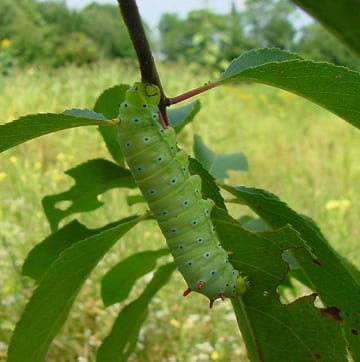
Generalist promethea moth caterpillar feeding on black cherry (Prunus serotina), a host plant used by many butterfly and moth species. Photo: Don Adams
Many pollinators, whether specialists or generalists, rely on native species for food, shelter, and habitat. In turn, we humans depend on these native pollinators for our food. According to the Xerces Society, native bees pollinated approximately $3 billion of crops in the year 2000, including many New England crops such as apples, cherries, squash, watermelon, blueberries, cranberries, and tomatoes, and doing so far more effectively than non-native honey bees on a bee-per-bee basis.
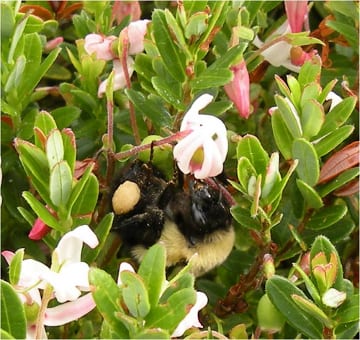
A pollen-loaded bumble bee forages on cranberry flowers. Cranberry is more efficiently pollinated when the flowers are ‘buzz pollinated.’ Bumble bees commonly do this by moving their flight muscles rapidly and vibrating the flower, which releases pollen. Photo: A. Averill
We still have much to learn about native bees, many of which may be adapted to gather pollen and nectar from native plants. In New England, we have over 400 native bee species, more than 45 of which have been recorded pollinating berry crops in Maine and Massachusetts. Many native bee species forage earlier or later in the day than the honey bees, and they will often visit flowers in wet or cold conditions when honey bees remain in the hive. With the decline of honey bees due to Colony Collapse Disorder, providing support to our native bee species has even greater importance. By planting a variety of natives with a succession of flowering through the growing season, we help sustain native bees by providing the essential continuous forage.

Female green sweat bee (Agapostemon sp.) collecting nectar from butterfly weed (Asclepias tuberosa). Photo: Cayte McDonough
Are all native plants created equal?
In recent years, native plants have become more widely available for purchase, but are all natives created equal? In reality, many nurseries produce plants vegetatively, with each resulting plant genetically identical to the original plant. Often growers or breeders select an individual for desirable characteristics, but in doing so they sacrifice genetic diversity, producing a crop that is uniform (and faster and less expensive to produce) but vulnerable to new diseases. Seed-grown plants, on the contrary, offer genetic diversity, which supports a stronger, more resilient population that is less susceptible to disease and disasters.
The trouble with clones
Plant clones have left a trail of problems throughout history into current times. In the mid-nineteenth century, widespread planting of a clone made the potatoes highly vulnerable to blight disease, resulting in the infamous Irish Potato Famine that caused widespread death and emigration. Bananas offer a current day example. All bananas we eat today are infertile clones, and two fungal diseases, Panama disease and black Sigatok, threaten the future of bananas. Half a billion people in Asia and Africa rely on bananas in some form as a staple in their diet. Over time (evidence shows that bananas were first domesticated about 7,000 years ago), hybridization and human cultivation have resulted in highly inbred bananas with weak genetic self-defense. Now scientists are working to unravel the fruit’s history in attempts to find undiscovered wild banana varieties that are resistant to disease and can be used to reverse the current trend.
Genetic diversity is a highly valuable resource that we need to protect. Consider the example of our native American chestnut, which was wiped out in New England starting in the early 1900s by chestnut blight, a fungal disease. As the blight reached Pennsylvania and southern Illinois, lumbermen quickly harvested remaining healthy specimens for the timber before it rotted. Though we may never know, it is possible that these hastily harvested individuals held genetic promise for chestnut blight resistance.
As nurseries today trend towards offering more cultivars and their use becomes more widespread, the cultivars supplant genetically diverse seed-grown specimens. By choosing to plant the cultivar, you are making a choice that is a triple threat to the wild type. First, you are not giving it a place to grow in your garden or landscape. Second, cross-pollination between a clone and a local population can alter and weaken the local population. For example, suppose your cultivar originated from a plant with less cold hardiness; if that clone cross-pollinates with a more northerly population, the resulting offspring could have reduced cold hardiness. Over time, the genetic strength of that population may be diluted. Third, you may be denying local pollinators and other wildlife of food they would otherwise get from a seed-grown plant. According to the Xerces Society, some horticultural hybrids and varieties may have been bred to produce showy blooms at the expense of nectar or pollen production.
Why seed grown natives?
We observe genetic diversity in action when we look at a seed-grown crop of New England American-aster (Symphyotrichum novae-angliae) in flower and see a wide range of flower colors—from pale pink to lavender to purple. This variability among plants allows them collectively, as a species, to be more adaptable to change. When faced with threats from pests, diseases, and climate change, a species with higher genetic diversity among its individuals has better prospects for long term survival.

New England American-aster grown from seed demonstrates genetic diversity through a wide variety of flower color. Photo Cayte McDonough
Over time, native plant populations have evolved and adapted to their local environmental conditions. Our native hobblebush (Viburnum lantanoides) is notoriously difficult to grow in nursery conditions. One year I grew this shrub from seed collected from two distant populations: one in northern Connecticut and the other in northwestern Maine. Both sets of seeds germinated and were nursery grown side by side in New England Wildflower Society’s western Massachusetts nursery. The plants grown from the Connecticut seed held their foliage through the summer heat while the Maine plants dropped leaves prematurely. Overall, the Connecticut plants were better adapted to the conditions in Massachusetts and were healthier as a result. The Maine plants could not thrive within our local conditions.
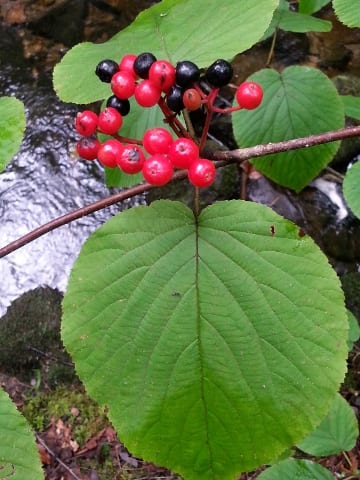
Native plants, such as hobblebush (Viburnum lantanoides), have evolved to withstand local environmental conditions. Photo: Cayte McDonough
Plants and the wildlife within an ecosystem have co-evolved over the centuries. When grown from seed, we can track the origin of the seed and make informed decisions about where it is most suitable to use the resulting plants. A plant grown from seed of local or even regional origin serves everyone better.
Many nurseries do not inform customers about the sources of their plants. When purchasing plants, ask your suppliers if they offer seed-grown plants and where that seed came from. Faced with demand from educated customers, growers will respond.
By growing plants from seed native to your region, you help support the health of your region and our planet, and perpetuate our sense of place, this place we call home. What can be more comforting than that?
References:
Bananas, Highly Inbred, at Risk. (2011, July 5). Retrieved from:http://news.discovery.com/earth/bananas-inbred-disease-pests-110705.htm
Cox, S. (1997). The American Chestnut Story. Retrieved from:http://www.landscapeimagery.com/chestnut.html
Mann, Charles C. (2001). 1493: Uncovering the New World Columbus Created. New York: Random House.
Norcini, Jeffrey G. (2007, Jan.). Native Plants: An Overview. University of Florida IFAS Extension, Publication #ENH1045. Retrieved from: http://edis.ifas.ufl.edu/ep297
Perrier, X., et al. (2011, May 25). Multidisciplinary perspectives on banana (Musa spp.) domestication. Proceedings of the National Academy of Sciences of the United States of America, vol. 108, no. 28, 11311-11318. Retrieved from:http://www.pnas.org/content/108/28/11311.full.pdf+html?sid=17f7bf80-33f9-4a6a-a458-715a88f106b5
Raver, A. (2008, March 6). To Feed the Bird, First Feed the Bugs. The New York Times. Retrieved from:http://www.nytimes.com/2008/03/06/garden/06garden.html
Tallamy, Douglas W. (2007). Bringing Nature Home: How Native Plants Sustain Wildlife in Our Gardens. Portland: Timber Press.
Vaughan, M., Shepherd, M., Kremen, C., and Black, S.H. (2011, Dec.).Farming for Bees: Guidelines for Providing Native Bee Habitat on Farms. The Xerces Society for Invertebrate Conservation. Retrieved from: http://www.xerces.org/wp-content/uploads/2008/11/farming_for_bees_guidelines_xerces_society.pdf
About the Author
Cayte McDonough is the Nursery Production Manager for New England Wild Flower Society’s Nasami Farm Native Plant Nursery based in Whately, MA. For the past 15 years she has worked to propagate, cultivate, understand, and promote New England native plants. She also enjoys learning about native pollinators and supporting local farmers. Cayte can be reached at cmcdonough@newenglandwild.org.
About the New England Wild Flower Society and Nasami Farm Native Plant Nursery
The mission of New England Wild Flower Society (www.NewEnglandWild.org) is to conserve and promote the region’s native plants to ensure healthy, biologically diverse landscapes. At our native plant nursery, Nasami Farm, we grow a wide selection of native species of perennial wildflowers, trees, shrubs, grasses and ferns from seed or spore. We start by acquiring landowner permission and then collecting seed of common species sustainably from the wild in New England. We strive to collect seed from large, robust populations to achieve high genetic diversity. From that seed, we propagate plants in plugs to supply our partner nurseries within the region. Using their expertise and facilities, our partners grow the plants we started from seed to finished retail size. We then offer those plants for sale at our two Massachusetts locations: Garden in the Woods in Framingham and Nasami Farm in Whately.
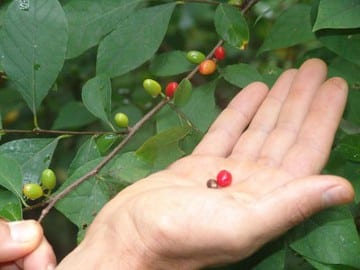
Native plants propagated by wild seed collected from large, healthy populations offer genetic diversity. Northern spicebush (Lindera benzoin) is an important food source for birds and butterflies. Photo: Cayte McDonough
We also offer contract growing of landscape-ready native plant plugs to other nurseries, organizations, and landscape professionals. Plugs are full plants with deep, healthy root systems that can quickly get established once planted in the landscape, and the cost per plant is significantly lower than the same species in a finished size container, making it very cost effective for large installations.During the 2013 growing season, we provided plugs for a variety of projects. For Groundwork Lawrence, undertaking a brownsfield reclamation effort in a former industrial site in Lawrence, Massachusetts, we grew 1600 plugs of 15 meadow species for installation of a pollinator garden and urban wildlife habitat, especially birds. At the University of Massachusetts Department of Environmental Conservation, researchers are conducting a study on how native plants support populations of native pollinators around cranberry bogs in southeastern and Cape Cod, Massachusetts. We supplied more than 700 plants comprised of 13 species for the project, meeting their need for native plants that offer a prolonged season of bloom and pollen for the pollinators. We have also partnered with and grown plugs for the Rhode Island Natural History Survey’s Rhody Native initiative, which is building the production of native plants for habitat restoration in Rhode Island.

